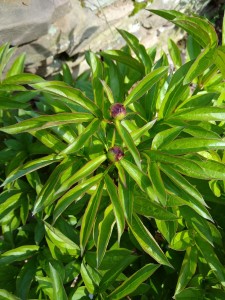
There may be some people who don’t love peonies. Fortunately I don’t know them. Ever since the first red tips of peony sprouts popped up a few weeks ago, I have been waiting impatiently for the day when they burst into big flamboyant blooms. Then I will say, “Damn the ants; full speed ahead,” and rush to pick a bunch for the house.
Drawn to the sticky nectar exuded by the buds, those ants are as much a part of the peony experience as color and fragrance. If you bring peony buds indoors, be sure to evict the ants before you cross the threshold. My mother, who loved peonies but was repelled by ants, was scrupulous about that step.
English writer and gardener extraordinaire Vita Sackville-West, made every plant sound like a poem, but she was uncommonly eloquent about peonies. Here is what she wrote:
“It always seemed to me that the herbaceous peony is the very epitome of June. Larger than any rose, it has something of the cabbage rose’s voluminous quality, and when it finally drops from the vase, it sheds its petticoats with a bump on the table, all in an intact heap, much as a rose will suddenly fall, making us look up from our book or conversation, to notice for one moment the death of what had still appeared to be a living beauty.”
In my garden this year the peonies will most likely open during the first half of May, rather than June, which only means less waiting time. What Vita calls “herbaceous peonies” are Paeonia lactiflora, or common garden peonies. You can buy them everywhere, making peonies the perfect combination of miraculous and ubiquitous. Right now, the big box stores feature boxed or containerized peony plants, generally labeled in prosaic fashion—“Peony-Pink” or “Peony Red”. In the better catalogs you can also find named varieties like the alluring ‘Festiva Maxima’, a nineteenth century peony distinguished by big full heads of white petals, each with a single spot of red at the heart. ‘Festiva’ always does a star turn on the garden stage.
The most common peony flower colors are white, pink or red, but breeders have expanded the color range to include coral, yellow and cream, not to mention maroon shades so dark that they look almost purple or black.
Some catalogs will send you plants now, others ship peony roots in the fall. To avoid disappointment, it pays to check this when you order.
When most people think of peonies, they imagine generic, fluffy-headed blooms, but the flowers unfurl into at least five different configurations. Single peonies feature one row of petals and look a little like giant anemones or super-sized poppies. Japanese varieties generally sport two rows of petals. Semi double, double and “bombe”-types feature successively increasing numbers of petals. The bombe peonies are crammed with them, generally massed into a large ball shape.
Peony history forms a very long arc. The plants are native to central Asia and have been cultivated by the Chinese since at least the seventh century. Roots and other parts have been also used medicinally at various times and places. Paeonia lactiflora was introduced to England in the 1780’s and reintroduced in 1807. The plants caught on and by the Edwardian era, which began after Queen Victoria’s death in 1901, they had become garden favorites. On top of all their other virtues, peonies have proven to be extremely durable. Deer turn away from them, and, if left undisturbed, they are fully capable of returning annually for decades.
In addition to their other virtues, peonies are relatively easy to grow. If you buy a potted specimen now, turn the peony out of the pot and plant so that the soil at the top of the root ball is level with the soil surrounding the planting hole. Water thoroughly and continue to water regularly if the weather is dry. The plants thrive in either full sun or very light shade.
If you order peony roots and plant in the fall, dig a shallow hole and position the root so that the “eyes”, from which new shoots will grow, are covered by only about two inches of soil. Planting too deep will delay or prevent the peony from growing. If winters are cold and snow is infrequent, mulch peonies with a layer of straw or other organic material.
Now, as the peonies are leaping up, is a good time to look at the “holes” in your planting scheme and think about filling them with this timeless flowering plant. For an excellent selection, go to Song Sparrow Farm and Nursery, Song Sparrow Farm; 13101 East Rye Road, Avalon, WI 53505; (608)-883-2356; www.songsparrow.com.
